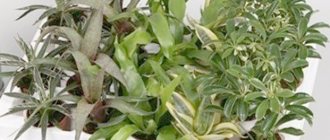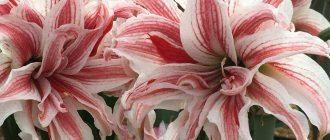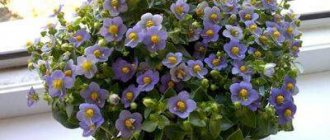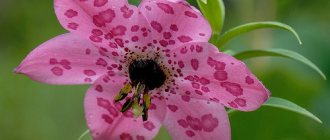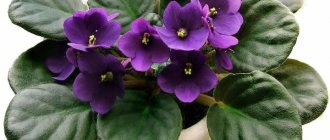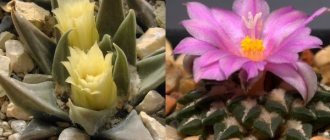Violet
This family includes mainly herbaceous perennials and annuals, as well as subshrubs and shrubs, standing and climbing plants.
There are twenty over eight hundred violet species in total, divided into twenty-eight genera. Herbs grow in the temperate zone, while shrubs and shrubs grow closer to the tropical zone. The violet leaves are bare, the upper ones are almost sessile, elongated, with stipules, the lower ones have a broadly ovate shape and long petioles. The leaf arrangement is usually alternate, sometimes biserial and very rarely opposite.
The flowers are either solitary or collected in the axils or at the ends of the shoots in panicles or racemes. Large flowers can be open or closed. In some species, the petals on a flower may have different colors and colors. Flowering usually lasts from mid-spring to autumn, and the fruits - oblong boxes, nuts or berries - begin to ripen from the beginning of summer.
It must be said that the shrub species of violets found in the Chilean Andes are so unusual that they do not at all resemble those violets that grow in our latitudes.
The most famous representatives of the Violet family can be called the amazing violet, dog violet, fragrant violet, white violet, field violet and many more species of this plant, as well as their varieties and hybrids.
How are raw materials procured?
Orris root is mainly used for culinary and medicinal purposes. It contains an essential oil that is found nowhere else in nature. It is the active ingredient.
You can collect iris roots only in the third year from the moment of planting, only then do they accumulate a large amount of useful substances.
It is recommended to dig up orris root no earlier than August, or even in September. The rhizome must first be washed under running water and the side roots cut off, and then dried a little. The raw material prepared in this way is then cut into halves lengthwise. This is done using a fairly sharp knife. Dry it in the air (but in the shade) or in a well-ventilated room. As a last resort, you can use a dryer, but only use the gentle mode.
The raw materials should be mixed regularly to avoid stagnation of air and moisture. The roots dried in this way are poured into paper bags or glass jars. They can only be stored in a dry place away from sunlight. Shelf life – 3 years.
Viola: growing from seeds, planting and care
Author: Marina Chaika February 20, 2022 Garden plants
plant (Latin Viola) belongs to the genus of the Violet family, representatives of which grow mainly in mountainous regions and places with a temperate climate in the Northern Hemisphere and, according to various sources, number from four hundred to seven hundred species. Some of the violas are endemic to the South American Andes, and a number of them are found in the subtropics of Brazil, the tropics of South Africa, Australia, the Sandwich Islands and New Zealand. Viola is popularly known as pansy .
The violet viola has been popular since time immemorial - about two and a half millennia ago, the ancient peoples inhabiting the territory of Europe wove the flower into festive garlands and wreaths, decorating the premises for celebrations with them. The fragrant violet was the first to be introduced into culture, followed by the mountain violet. The first mention of breeding work on violet hybrids dates back to 1683. Europeans became acquainted with the Wittrock viola species, which is a hybrid of yellow viola, Altai viola and tricolor viola, in the 19th century. Today, garden viola is one of the most popular plants, with hundreds of varieties and varieties.
Taxonomy
The family is divided into three subfamilies - Violeae, Rinoreeae and Paypayroleae - and includes 28 genera.
- Acentra Phil.
- Afrohybanthus Flicker
- Agatea A.Gray - Agatea
- Allexis Pierre - Allexis
- Amphirrhox Spreng.
- Anchietea A.St.-Hil. — Anchietea
- Calyptrion Ging.
- Cubelium Raf. ex Britton & A.Br.
- Decorsella A.Chev. — Decorsella
- Fusispermum Cuatrec. — Fusispermum
- Gloeospermum Triana & Planch. — Gleospermum
- Hekkingia HE Ballard & Munzinger
- Hybanthopsis Paula-Souza
- Hybanthus jacq. — Gibanthus
- Isodendrion A.Gray
- Ixchelia HE Ballard & Wahlert
- Leonia Ruiz & Pav. — Leonia
- Mayanaea Lundell
- Melicytus JRForst. & G. Forst. — Melicitus
- Noisettia Kunth
- Orthion Standl. & Steyerm.
- Paypayrola Aubl.
- Pigea DC.
- Pombalia Vand.
- Rinorea Aubl. — Rhinorrhea
- Rhinoreocarpus ducke
- Schweiggeria Spreng.
- Viola - Violet
Violet family (Violaceae)
Life of plants: in 6 volumes. — M.: Enlightenment. Edited by A. L. Takhtadzhyan, editor-in-chief, corresponding member. USSR Academy of Sciences, prof. A.A. Fedorov. 1974.
See what “Violet family (Violaceae)” is in other dictionaries:
VIOLACEA FAMILY (VIOLACEAE) - amazing violet (and a plant with fruits); white violet; fragrant violet; dog violet; There are 18 genera and 850,900 species in the family, more than half of which belong to the Violet genus. The Violet genus has a wide range and is found in... ... Forest herbaceous plants
Related article: Fruit plants: names and photos of garden plants that bear fruit
Violaceae - ? Violet Viola banksii Scientific classification Kingdom: Plants Division: Coverings ... Wikipedia
Violet - Viola banksii ... Wikipedia
VIOLATES - order (Violates) and family (Violaceae) of dicotyledonous plants. The F. order is close to the tea and malvaceae and probably has a common origin with them from the ancestors of the Dilleniaceae. Trees, shrubs and grasses b. parts with alternate leaves with stipules ... Biological encyclopedic dictionary
Violets - (Violaceae) family of dicotyledonous plants of the order Cistiflorae. These are in most cases (Viola, Hybanthus species) annual or perennial herbs, rarely subshrubs (Viola species), erect or climbing (lianas) shrubs... ... Encyclopedic Dictionary of F.A. Brockhaus and I.A. Efron
Violets - (Violaceae) family of dicotyledonous plants. Herbs, shrubs, subshrubs, and less often small trees. The leaves are simple, usually entire, with stipules. Flowers are irregular or regular, mostly bisexual, solitary or in... ... Great Soviet Encyclopedia
Violet (violets) - ? Violet Violet tricolor (Viola tricolor) Scientific classification Kingdom: Plants ... Wikipedia
Violet - This term has other meanings, see Violet (meanings). Violet Violet tricolor (Viola tricolor) Scientific classification ... Wikipedia
List of species - List of species included in the Red Book of the Yaroslavl Region List of species included in the Red Book of the Yaroslavl Region, published in 2004. The Red Book of the Yaroslavl Region includes 14 species of mushrooms, 173 species of plants and 172 species of animals.... ... Wikipedia
List of species listed in the Red Book of the Yaroslavl Region - List of species listed in the Red Book of the Yaroslavl Region, published in 2004. The Red Book of the Yaroslavl Region includes 14 species of mushrooms, 173 species of plants and 172 species of animals. The classification is given by edition. Contents 1 Kingdom Mushrooms ... ... Wikipedia
Where are you from, pretty violet?
For many girls, growing indoor violets becomes a real hobby. The flower has a capricious disposition and needs care and regular maintenance. In a word, the violet is an amazing and at the same time very demanding beauty flower. When you fulfill all her whims and whims, the return will be maximum. Indoor plants will delight you with their stunning appearance and pleasant aroma.
- Features of Saintpaulia, its appearance
- The most extraordinary story about the origin of Saintpaulia
- We also recommend reading
- Professional gardeners - about the nuances of care
- Soil preparation for Saintpaulia and watering features
- How do plants reproduce?
Show all content
Most often, Saintpaulia is found on the windowsills of apartments, the reproduction of which does not cause serious difficulties. The flower of the plant has a blue or purple color. Violet (the plant's homeland is the countries of East Africa) has more than 20 varieties and varieties. The violet family is quite rich, so every gardener will be able to choose those types of indoor violets that will definitely suit his taste.
Related article: Scale insects and false scale insects - control on plants, types of scale insects and preparations against the pest
Features of Saintpaulia, its appearance
You already know that the birthplace of violets is Africa. Saintpaulia is a perennial plant up to 30 cm high. It has a short stem, large leaves, and an oval shape. Some types of violets have heart-shaped or elongated leaves. The color also differs - from light to dark green.
Visual photos confirm the incredible variety of colors and shapes. You can find a flower with double, corrugated, wavy or fringed petals. The average diameter is 2-4 cm, both single-color and multi-color colors are found. Night violet and Labrador violet, swamp violet and butterfly violet... It seems as if all these varieties are competing with each other in beauty.
Previously, indoor Saintpaulia had no smell and pleased gardeners solely with its appearance. As a result of long and painstaking breeding work, hybrids with a subtle, very pleasant aroma were bred.
The most extraordinary story about the origin of Saintpaulia
One of the main questions of our article is as follows: when and under what circumstances was the plant discovered? Baron Walter von Saint-Paul, who was the governor of an African state, knew exactly what a violet looked like. While exploring the Ulugur and Uzambara mountains, the researcher met a flower that captivated him with its beauty. The sky-blue radiance surprised Saint-Paul so much that he immediately wrote up a description of it and sent it to his father, a well-known orchid collector at that time.
We also recommend reading
At first, the night violet was “enlisted in the ranks” of the Gesneriaceae family.
The official year of birth of the flower was 1893, when the plant was described in detail and officially presented at an international exhibition.
Having earned recognition, the violet, whose homeland was the African continent, almost instantly adorned window sills in most countries of the world.
Miniature sorceress Saintpaulia - queen of indoor plants
Saintpaulia (Saintpaulia) - this genus was formed by beautifully flowering herbaceous plants, which are an adornment of the Gesneriaceae family, and also maintain the highest level of popularity among house flowers. Saintpaulia's closest relative is Koleria .
The Saintpaulia flower considers the mountainous areas located in East Africa to be its homeland. Wild violets have chosen coastal river areas with their inherent beautiful waterfalls, which are rich in Kenya and Tanzania.
The flower-loving public owes its gratitude for the appearance of the amazing violet to a certain Baron Walter von Saint-Paul, who, absolutely by accident, in the year one thousand eight hundred and ninety-two, met a wonderful flower at the foot of the mountains called Uzambara, located in Tanzania. The collected violet seeds were immediately sent to the Dendrological Society of Germany. The botanist Wendland planted the seeds, grew a wonderful plant, described it, named Saintpaulia violetflower in honor of the discoverer and separated it into an independent genus.
The demonstration of an amazingly beautiful miniature miracle, with a long flowering period, at the World Flower Exhibition, accelerated the process of getting to know the flower. The result was not long in coming. The African violet immediately did not leave flower growers indifferent and won the championship in the family of home plant growing.
Breeders have been constantly and intensively working for many years to create new amazing, numerous hybrid varieties of Saintpaulia. The fame and glory of the Uzambara violet was brought primarily by the fact that the plant is in bloom, its compactness and unpretentiousness.
African violet flowerpots are low herbaceous plants with small roots and round, hairy, fleshy leaves. The miniature basal rosette is organized by green leaves with various spots, they are presented with shortened succulent stems.
Five-petalled flowers are collected in original inflorescences-tassels. The Saintpaulia calyx has five sepals. The result of flowering is numerous small seeds, neatly hidden in the fruit-box. In the natural environment, flowers are blue, purple, and blue.
Thanks to the successful work of modern breeders, the range of colors has been expanded. After all, now the Saintpaulia violet has organized a company of twenty thousand Uzambara violets.
Important! Do not mix representatives of two different genera from completely different families.
Violet (Viola) from the Violet family - the general name of this beauty is the Pansy , also known as tricolor , forest, garden violet. Interesting information will be discussed in another article.
And now in detail about African flowers, which have won the attention and love of flower growers around the world. Incomparable Uzambara violet - indoor Saintpaulia flowers, numerous varieties. Saintpaulia photo can be viewed further.
Professional gardeners - about the nuances of care
Planting and care have their own specifics. The plant does not like cold and reacts to it very quickly. Humidity and light are a completely different matter. But here it is important not to overdo it. For a plant such as violet, almost all species need shade if it is a hot and sunny day outside. The duration of daylight hours should be 13-14 hours.
Violet is an amazing, delicate “beauty” among other flowers. Gardeners love marsh violet, butterfly violet and some other varieties for their prolific flowering (sometimes up to 9 months). So that you can observe beautiful flowering for as long as possible, planting and care should also include sufficient lighting. To do this, creeping violet and night violet are placed on window sills that face west, east or north. Windows on the south side are also suitable, but it is advisable to place the pots on a table or shelf at the back of the room or to the side of the window.
As for temperature, the range from +18 to +24 is considered optimal. In violets, growth and reproduction deteriorate when there are changes in cold and heat in the apartment.
Pansies are rarely found in apartments and private houses (violet does not grow well in greenhouse conditions), as well as marsh violet. Preference is given to hanging varieties. They are distinguished by rather voluminous rosettes, stems falling down.
Related article: List of plants starting with the letter F: indoor, garden and vegetable gardens
Short description
Growing violets at home will not be difficult if you familiarize yourself with the characteristics of the plant in advance. So, it is important to know the following:
- Flowering occurs almost all year round;
- Lighting for normal flower growth should be bright, mostly diffused. If you need to choose a window to place flower pots, it is better to look in the northwest, northeast or north;
- Temperature also affects flowers, since the intensive growth phase requires heating from 18 degrees to 24, and in winter the room should not be colder than 15 degrees;
- Watering is done systematically, no more than twice a week. Once every week and a half, it is best to use the bottom watering method;
- The appropriate air humidity is that which is typical for residential premises;
- Fertilizers are required in small quantities only during the active growth phase. Complex mineral fertilizer for flowering indoor plants is applied to the soil three times a month.
- The dormant period is not clearly visible, although in the winter months it is better to allow the bushes to rest;
- Replanting is permissible once a year, but there is no need to increase the capacity of the pot; it is enough to simply replace the soil mixture;
- Reproduction occurs using the seed method, children and leaf cuttings;
- Pests can cause serious damage to the plant. The list of enemies of violets includes aphids, nematodes, spider mites, whiteflies and others;
- Diseases include rust, late blight, powdery mildew, gray mold and fusarios.
Soil preparation for Saintpaulia and watering features
Perennial violet is planted in plastic pots with a diameter of 5 to 9 cm. Due to the root system of a superficial type, it is recommended to give preference to flat pots. Loose soil that absorbs water well and allows air to pass through is suitable. The store sells a ready-made base, although you can prepare it yourself. In order for the horned chrysalis violet and the Rococo variety to grow well, it must consist of 2 parts of humus and 2 parts of turf soil, 4 parts of half-rotten foliage, pine soil, sand and charcoal (1 part each). A bucket of this mixture is mixed with half a glass of ash and superphosphate (2 tablespoons).
Be sure to run hot water over the pot before filling it with soil. This will destroy harmful microbes.
In order for the night violet to bloom profusely, as in the photo, it needs to be periodically fed with fertilizers. You can mix them directly into the soil or dilute them with water for complex watering. In the second case, the concentration decreases by 6-7 times. This will prevent the plant from burning.
Also make sure that the vetch and garden violet are not covered with white dust. This deprives the flower of its aesthetics and prevents it from developing and breathing normally.
To prevent white dust from appearing, night violet and viola are watered with warm water twice a month. It is advisable to immediately cover the soil with paper or polyethylene. It is recommended to carry out water procedures in the evening or early in the morning. The plant will be able to dry out before the first rays of the sun touch it.
For watering, use tap water, previously brought to a boil and cooled.
Diseases, pests
We indicated most of the consequences of improper care above, where we wrote what violets need for health and well-being.
But there we did not indicate why there may be no flowering. So, if your Saintpaulia is looking healthy but not blooming, check the following factors:
- Is the pot too big? Otherwise, the plant will first spend a lot of time absorbing the entire soil with its roots, and then it will no longer have enough nutrients for flowering. Each next pot should be just a couple of centimeters larger in diameter than the previous one. If a mistake has already been made, transplant the flower again, into a slightly smaller container.
- Too frequent replanting gives the same result: as soon as the plant has mastered the entire soil with its roots and is ready to redirect all its forces to flowering, you give it the next stress and add fresh soil, which, again, needs to be filled with roots.
- An excess of nitrogen or a lack of potassium-phosphorus fertilizers also leads to foliage growth to the detriment of flowering.
- If the roots are cold, the plant is also forced to survive, and not waste energy on reproduction. In winter, window sills are cold, so place a circle of foam under the flowerpot. Ceramic pots cool much more than plastic ones. You can also create the effect of a thermos: plant a violet in a simple small plastic pot, and place it on a layer of perlite in a beautiful, slightly larger one; You can also fill the space on the sides with perlite.
- Like any other plant, violets do not bloom if they do not have enough light.
- Clover cutworms, sciarids and violet mother of pearl eat the leaves - treatment with a systemic insecticide is required: spray the foliage and shed the soil.
- The mealybug leaves white flakes on the leaves and their petioles; urgent treatment with Mospilan or Regent is necessary.
- The cyclamen mite is a microscopic insect, the presence of which can only be guessed by the curling of new leaves and the arrest of development. Immediate isolation of the plant and treatment with insecticides is required.
- The red spider mite leaves thin webs on the leaves and is afraid of acaricides, but not insecticides.
- The whitefly can be seen with the naked eye - it looks like a moth, but is white.
- Thrips are beige or brown, long, leave silvery spots on the leaves, and feed on plant pollen. They can be carriers of leaf bronzing virus. They are expelled with a decoction of ash or insecticides; the entire plant and the top layer of soil must be treated.
- Aphids are very small insects that feed on the sap of leaves, leaving small dry spots at the bite sites and a sticky coating. Spraying with a solution of laundry soap, potato tops or tobacco will help evict it; if there are already a lot of insects, use insecticides. You can bring a ladybug into your house - it feeds on aphids.
- The strawberry nematode lives in the leaves and flowers of the plant, feeding on their sap.
- Root-knot nematodes, pratylenchis, short-bodied wounding nematodes and paralongidorus major live in the roots of Saintpaulias, leaving spherical thickenings on them, and the aerial part sharply reduces the rate of development and loses its beauty. You will have to throw away such a violet; you can only try to root its top (the center of the rosette, not the lower leaves).
- Powdery mildew is a white or grayish spotted coating (as if powdered with flour) on the green part of the plant, later with black dots. Treatment is urgent treatment with fungicides.
- Rust - swellings on the leaves with a red powder. Treatment is to remove all damaged parts, treat the rest with bayleton, benzomil, topaz, tilt or folicur.
- Leaf spot produces a wide variety of spots, and over time, the affected leaves die.
- Fusarium is root rotting that spreads to the stems and above. Urgently isolate the affected plant, you can try to water it with a fungicide, but most likely you will have to throw it out along with the soil and sterilize the pot.
- Smut - swellings on any above-ground part of the plant with black powder - a fungal disease, treated with fungicides.
- Blackleg affects Saintpaulia at the very first stages of development - the stem and petiole turn black and dry out, the entire plant dies in a few days. There is no treatment, prevention is sterilization of the soil for seedlings, treatment of seeds with fungicides, periodic watering with a weak solution of potassium permanganate. If one plant in a common nursery has died, the soil is dried and covered with sand or ash.
- Gray rot is a fluffy gray coating, like mold, on flowers - remove damaged parts, reduce watering, use soils that retain less moisture.
- Rot of the roots and base of the stem leads to yellowing of the leaves and the appearance of a white or brown coating. Develops with excess moisture or in acidic soils. It is possible to save a diseased plant only by cutting off all damaged parts and rooting healthy ones in a new substrate. Contaminated soil should be immediately thrown into the trash and the pot should be sterilized.
- Variegation of flowers (cucumber mosaic) also leads to drying of the tips of the leaves. Infection usually occurs through aphid bites.
- Tobacco ringspot virus - circles of dead tissue on leaves with a dark green center.
